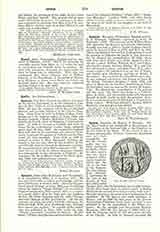

Speyer, Diocese of (SPIRA), in Bavaria. The city dates back to the stronghold of Noviomagus, in the territory of the German tribe of the Nemetes, on the left bank of the Rhine. In the course of time a Roman municipality (Colonia Nemetum) developed out of this stronghold; in 451 the municipality was entirely destroyed by Attila. From its ashes arose a new city, Spira or Speyer. Christianity found entrance into the city in the time of the Romans. The first bishop, Jesse (Jessius), is mentioned in the Acts of the Synods of Sardica (343) and of Cologne (346), but his historicity is not quite certain. On the other hand there is positive proof of Bishop Hilderich who attended the Synod of Paris held in 614. Since his episcopate the succession of bishops has been unbroken. In 748 Speyer was made suffragan of Mainz; and in 1030 the first stone of the present Romanesque Cathedral of Our Lady was laid; it was intended to be the mausoleum of the Salian emperors. In the struggle over investitures, Bishops Huzmann (1073-90) and Johann I (1090-1104) up-held the Emperor Henry IV and died under the ban of the Church. In 1146 St. Bernard preached the Crusade at Speyer and won King Conrad III to the cause. Besides the four Salian emperors, Philip of Swabia, Rudolph of Habsburg, and the rival kings, Adolph of Nassau and Albert of Austria, are also buried in the cathedral. A lay brotherhood, the Twelve Brothers of Prayer, prayed without intermission in the cathedral, for the repose of the souls of these kings. Among the later bishops Matthias of Ramung (1464-78) should be especially mentioned for his reforming the clergy and people, and bringing new life into the diocese.
At the time of the Reformation several Diets were held at Speyer, the most important being in 1526 and 1529. In 1526 the condition of political affairs enabled the Protestants to secure the relatively favorable decision that each constituent state should act in reference to the matters contained in the Edict of Worms (1521) as it could answer to God and the emperor. But the action taken in 1529 was more decided: the Edict of Worms was to be executed and the ecclesiastical innovations were to be abolished. Against this the Evangelical constituents protested. By the Reformation the diocese lost two thirds of its churches and benefices. Bishop Eberhard von Dienheim (1581-1610) sought to introduce the reforms ordered by the Council of Trent in the remaining territory. The gains temporarily acquired during the Thirty Years’ War were nearly all lost by the Treaty of Westphalia (1648). The diocese suffered greatly during the predatory wars of Louis XIV of France, and in 1689 the city and cathedral were burned. In 1794 the cathedral, which had been restored at great expense, was once more ravaged by the lawless soldiery of the French Revolution. In 1801 that part of the diocese on the left bank of the Rhine had to be ceded to Mainz; in 1815 the diocese was assigned to Bavaria; in 1817 it received new boundaries in the Bavarian Concordat and was made suffragan of the new metropolitan Bamberg. By the liberality of King Louis I of Bavaria, the cathedral was suitably decorated (1846-53), the frescoes being done by Schraudolph. The area of the diocese corresponds to that of the Bavarian Palatinate of the Rhine. Dr. Michael Faulhaber, formerly a professor at the University of Strasburg, was appointed bishop in 1910. The diocese has 12 deaneries, 235 parishes, 6 curacies, 86 chaplaincies and vicarships, 377 secular clergy, and 10 regular clergy. The Catholic population is 413,-481; the Protestant population is about 500,000. The diocese has also 1 Dominican monastery (Oggersheim), 1 Capuchin monastery (St. Ingbert), and 100 houses for nuns.
KLEMENS LOFFLER

